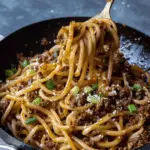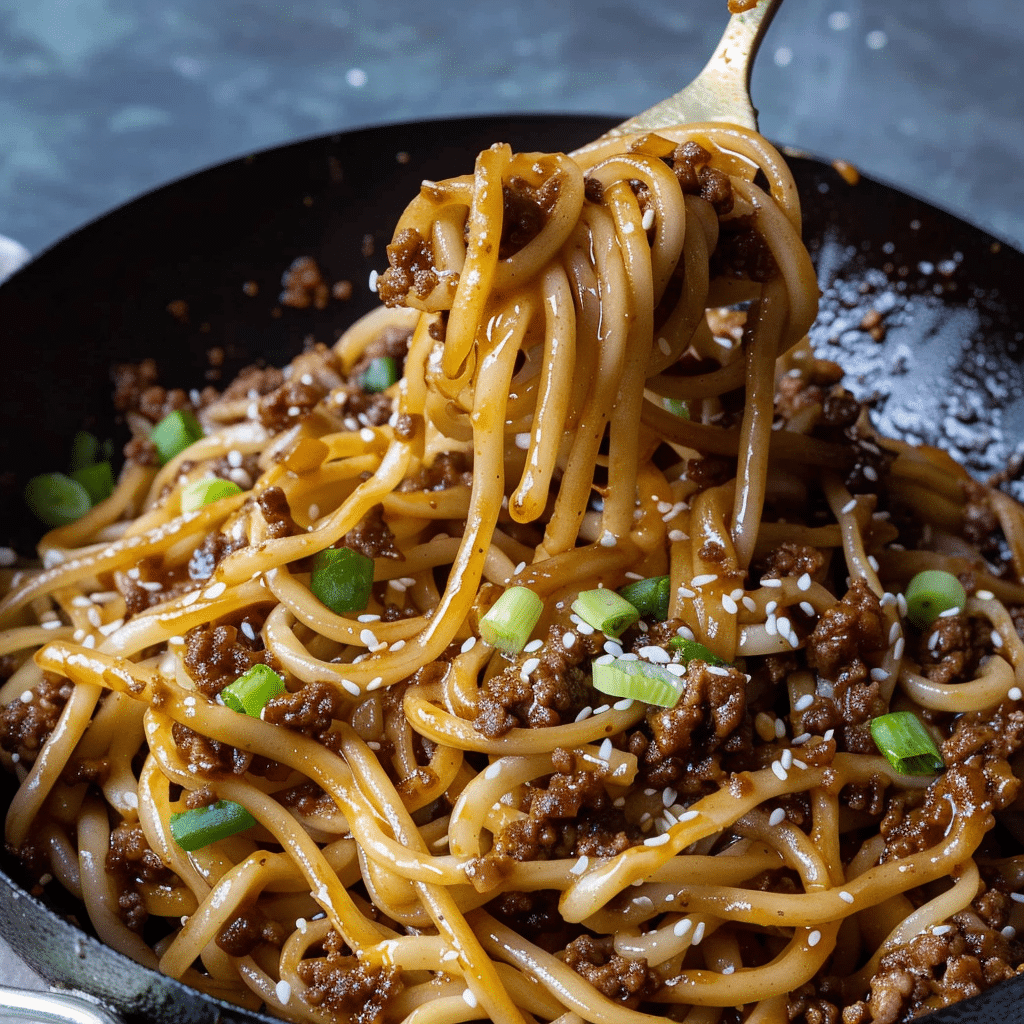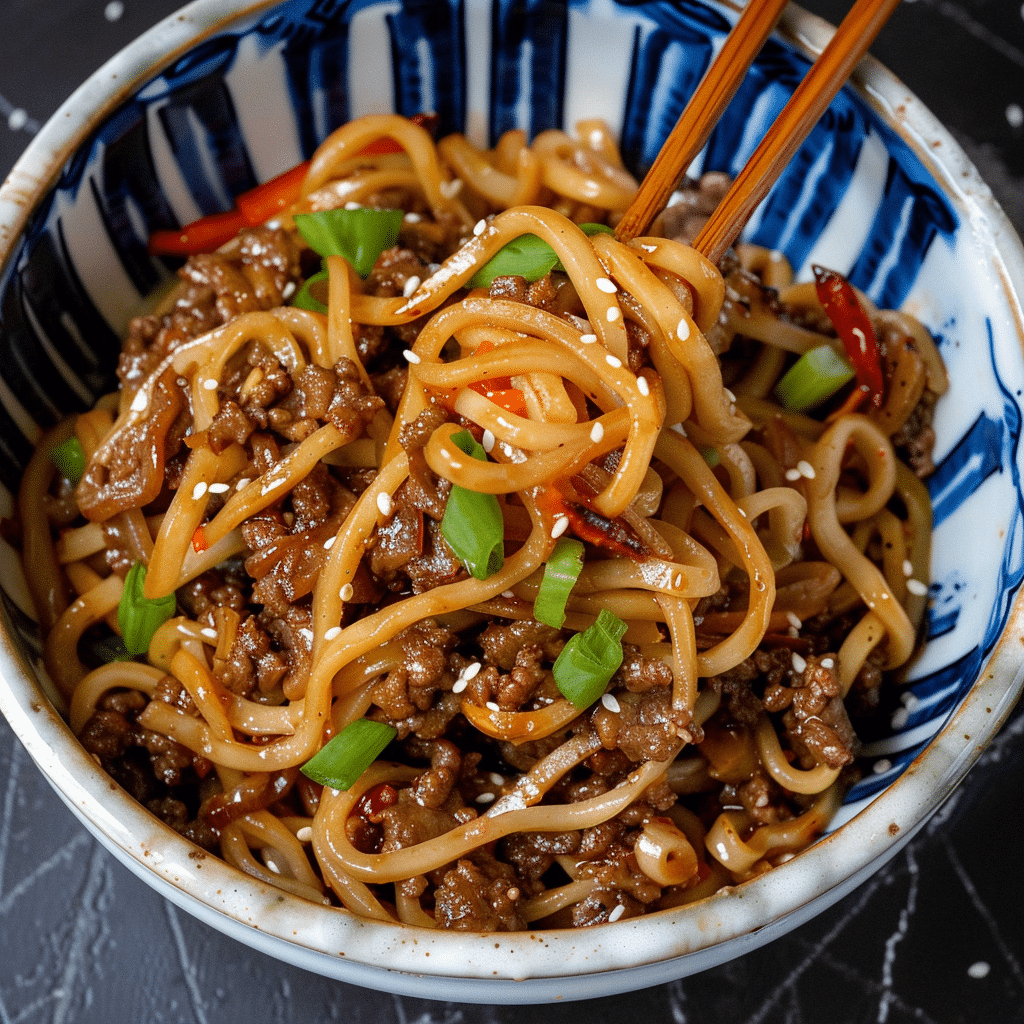Mongolian Ground Beef Noodles are a perfect weeknight meal ready in under 30 minutes, featuring savory ground beef coated in a sweet and zesty ginger-garlic sauce. This article reveals the simple steps to mastering the popular Asian-American flavor profile right in your kitchen, ensuring a family favorite dinner.
Key Takeaways
- Achieve authentic Mongolian flavor in just 20 minutes total time.
- The simple sauce uses soy, hoisin, and brown sugar for the perfect balance.
- A cornstarch slurry is key for achieving a thick, glossy, restaurant-style sauce.
- It’s a versatile dish; substitute the noodles or beef easily for variety.
Mongolian Ground Beef Noodles is an easy, fast dinner that combines browned ground beef with a rich, savory-sweet sauce made from soy sauce, brown sugar, hoisin, and fresh aromatics like ginger and garlic. You simply cook the beef, whisk in the sauce, thicken it with a cornstarch slurry, and toss it all with your favorite pasta or Asian noodles for a complete meal in about 20 minutes.
Why Mongolian Ground Beef Noodles Are a Weeknight Hero
Mongolian Ground Beef Noodles are perfect for those busy nights when you need dinner on the table fast. The recipe utilizes ground beef, which cooks quickly and absorbs the flavorful sauce much better than larger cuts of steak. You will be amazed at how much flavor you can build in such a short amount of time, making this a frequent part of your dinner rotation.
This dish is a comforting blend of savory, sweet, and tangy notes that appeal to nearly everyone at the table. It provides a satisfying, hearty meal without requiring hours of preparation or expensive ingredients. It is a fantastic option for transforming simple pantry staples into a restaurant-quality meal.
Starting with the Star: Ground Beef Preparation
You need to start with lean Mongolian Ground Beef Noodles to prevent the final dish from becoming too greasy. Cooking the beef over medium-high heat is essential to achieve a nice, golden brown crust on the meat. This browning process, called the Maillard reaction, adds a crucial depth of savory flavor.
Remember to add your aromatics, the minced garlic, and grated fresh ginger, during the last two minutes of browning the beef. This timing is vital as it allows the aromatics to become fragrant without burning. Burnt garlic will turn bitter and spoil the entire flavor profile of your sauce.
The Importance of Draining the Fat
Draining the excess fat from the ground beef after browning is a step you should never skip. Too much residual fat can make the sauce oily and prevent it from properly clinging to the noodles. Use a spoon or tilt the pan and use paper towels to carefully remove any rendered fat before moving on.
Choosing the Right Beef Ratio
While lean beef is recommended, you can use an 85/15 ratio if you prefer a slightly richer flavor. Just be extra diligent about draining the fat before adding the sauce ingredients. The goal is a rich, flavorful sauce, not a greasy one.
The Secret to the Signature Mongolian Sauce
The Mongolian Ground Beef Noodles sauce is a delightful balance of sweet, salty, and savory components. The key ingredients include low-sodium soy sauce for saltiness, brown sugar for sweetness, and hoisin sauce for deep, complex umami flavor. Mixing these three forms the backbone of the Mongolian profile.
You should use low-sodium beef broth to control the overall salt level, as soy sauce already contributes significant sodium. Feel free to adjust the amount of brown sugar to suit your personal preference for sweetness. This is your chance to really make the sauce taste perfect for you and your family.
Balancing Sweet and Savory Notes
The combination of brown sugar and soy sauce creates the classic sweet-and-savory contrast that defines this cuisine. If you like a little heat, add the 1/4 teaspoon of red pepper flakes into the sauce at this stage. You can always add more later, but you cannot take it out.
Why Hoisin Sauce is Non-Negotiable
Hoisin sauce is essential; it brings a thickness and depth of flavor that cannot be easily replicated. This thick, fragrant sauce is commonly used in Chinese cuisine as a glaze or dipping sauce, lending a slightly sweet and tangy profile to the final dish. It really ties all the components together.
Mastering the Cornstarch Slurry for a Thick Sauce
Creating a cornstarch slurry is the professional way to thicken your Mongolian Ground Beef Noodles sauce without lumps. A slurry is simply cornstarch mixed with an equal part of cold water, whisked until completely smooth. The cold water is important because hot water will cause the cornstarch to clump immediately.
When you pour the slurry into the simmering sauce, you will notice the thickening happen almost immediately. Stir continuously for 2-3 minutes, and the sauce will transform into a glossy, beautiful coating. This thickening process ensures the sauce sticks beautifully to the noodles instead of running to the bottom of the dish.
Noodle Selection and Preparation Tips
The recipe suggests using linguine or fettuccine noodles, which provide a wide surface area to catch the rich sauce. You can also successfully use traditional Asian options like wide egg noodles or lo mein noodles. The best choice is whatever you have on hand, as the sauce is the main star here.
You must cook the noodles until they are “al dente,” meaning they are still slightly firm in the center. Remember they will continue to soften slightly when tossed with the hot sauce. Overcooked noodles will become mushy when mixed into the skillet, which nobody wants for dinner.
The Art of the Final Toss
After draining the noodles, immediately add them back to the skillet with the thickened sauce and beef. Toss the noodles gently but thoroughly to ensure every strand is coated in the glossy sauce. This step is a great way to bond the flavors together seamlessly.
Allowing Time for Flavor Absorption
Letting the mixture sit for 2-3 minutes after the final toss allows the noodles to absorb some of the sauce’s flavor. This brief pause prevents a watery dish and ensures a deeply seasoned, satisfying bite. This minor waiting period is crucial for the best outcome. You can find more quick dinner ideas in our Dinner Recipes section.
Garnishing for Finish and Presentation
The final touch of sliced green onions adds a necessary element of freshness and a mild, oniony bite that cuts through the richness of the sauce. This provides a beautiful contrast in color and texture. Do not add the green onions while cooking, as they will lose their bright color and crispness.
Sprinkle the green onions over each serving right before bringing the dish to the table. For extra flair, you can also add a sprinkle of sesame seeds, which enhances the nutty aroma and adds a subtle crunch. A perfect garnish completes the dish aesthetically and texturally.
Adjusting Spice and Sweetness Levels
You have full control over the flavors in your Mongolian Ground Beef Noodles. For a spicier dish, you can increase the amount of red pepper flakes or even add a dash of sriracha to the sauce. Start small and taste as you go, adjusting to your heat tolerance.
If you find the sauce too sweet, you can balance it by adding a teaspoon of rice vinegar or a little extra soy sauce. Conversely, if it is too salty, a pinch more brown sugar can quickly correct the balance. Always taste the sauce before you add the slurry.
Serving Suggestions for a Complete Meal
To make this a complete meal, you can serve the noodles alongside a simple, crisp vegetable. Steamed broccoli or a quick stir-fry of snap peas works wonderfully with the rich sauce. This adds fiber and color to your plate.
A refreshing side salad, like a simple cucumber and carrot slaw with a light vinaigrette, provides a nice acidic contrast. You can also find great side dish inspiration by checking out our other recipes, such as the Crispy Cauliflower article.
Ingredient Swaps for Dietary Needs
If you need a gluten-free option, you can easily substitute the soy sauce with tamari or a certified gluten-free soy sauce alternative. Just be sure to check that your hoisin sauce is also gluten-free, as some brands contain wheat. This makes the dish accessible for more people.
You can also swap the ground beef for ground turkey, ground chicken, or even crumbled plant-based meat substitutes. For vegetarian main courses, try using firm tofu or mushrooms instead of meat, adjusting the cooking time as necessary.
The Popularity of Ground Beef Noodles
The popularity of Mongolian Ground Beef Noodles lies in their simplicity and powerful flavor profile. Ground beef is an affordable and versatile protein that quickly absorbs marinades and sauces. This makes it a great candidate for fast-cooking Asian-inspired dishes.
This meal falls into the beloved category of “noodle bowls” or “pasta with a twist,” offering a familiar comfort food texture with exotic seasoning. It is far quicker than ordering takeout and tastes fresher because you made it yourself. This kind of quick preparation keeps dinner exciting and achievable.
Storage and Reheating Instructions
Leftover Mongolian Ground Beef Noodles can be stored in an airtight container in the refrigerator for up to 3 days. The noodles may absorb more sauce as they sit, but the flavor will remain intense. This makes it a perfect dish for meal prepping lunches.
To reheat, the best method is to use a skillet over medium heat with a splash of water or broth to prevent dryness. Avoid using the microwave if possible, as it can cause the noodles to become tough. You want to maintain the beautiful texture and sauciness. You can always share your creations with us on Pinterest and Instagram.
Comparing with Classic Beef and Broccoli
While similar in flavor base (ginger, garlic, soy), this noodle dish is distinct from classic beef and broccoli. Traditional Mongolian beef often uses flank steak that is velveted and stir-fried, served over rice. This recipe uses ground beef and mixes it directly with noodles, making it a true one-skillet meal.
The use of ground beef changes the texture and shortens the cooking time considerably. It provides a more integrated, saucy experience where the meat and noodles are inseparable. It’s an accessible and quick interpretation of the beloved Asian-American flavor. Read more about the classic preparation of this type of cuisine on Wikipedia.
Troubleshooting Common Recipe Issues
If your sauce is too thin, you likely need to add a bit more of the cornstarch slurry. Mix another small batch (1 teaspoon of cornstarch to 1 teaspoon of cold water) and stir it into the simmering sauce. Give it a minute or two to thicken before serving.
If your sauce is too thick and gloppy, whisk in a tablespoon of beef broth or water until it reaches the desired consistency. Remember that the sauce thickens as it cools, so it is better to err slightly on the side of a runnier sauce right off the heat.
Mongolian Ground Beef Noodles
Mongolian Ground Beef Noodles are a fantastic way to bring bold, satisfying flavors to your dinner table in a flash. You can confidently create this takeout favorite with simple ingredients and minimal effort, thanks to the robust sweet and savory sauce. You will love how quickly this recipe comes together, making it a staple for busy weeknights.
You now have a reliable, quick, and incredibly flavorful recipe for Mongolian Ground Beef Noodles that the whole family will ask for again and again. Feel free to adapt the recipe with different vegetables or proteins, always remembering the simple power of the ginger-garlic hoisin base.
Print
Ground Beef Mongolian Noodles
- Total Time: 20 minutes
Description
This quick and tasty dish features tender ground beef coated in a sweet, savory sauce with garlic, ginger, and hoisin flavors. Tossed with noodles for an easy 30-minute meal.
Ingredients
For the Noodles
-
- 8 oz linguine or fettuccine noodles
For the Beef and Sauce
- 1 lb lean ground beef
- 4 tsp fresh grated ginger
- 6 cloves garlic minced
- 1/2 cup brown sugar
- 1/2 cup low-sodium beef broth
- 1/2 cup low-sodium soy sauce
- 1/4 cup hoisin sauce
- 1/2 tsp black pepper
- 1/4 tsp red pepper flakes optional
- 2 tbsp cornstarch
- 1/4 cup water
- 4 green onions sliced (for garnish)
Instructions
- In a skillet, cook beef over medium-high heat until browned, about 5 minutes. Add ginger and garlic during the last 2 minutes of cooking the beef.
- Meanwhile, cook noodles according to package instructions until al dente. Drain the cooked noodles and set them aside.
- Drain any excess fat from the browned beef mixture.
- Add brown sugar, beef broth, soy sauce, hoisin sauce, black pepper, and red pepper flakes (if using) to the skillet with the beef. Stir well to combine all sauce ingredients.
- In a small separate bowl, whisk together the cornstarch and water to create a smooth slurry. Pour this cornstarch slurry into the beef mixture.
- Bring the mixture to a simmer and stir continuously until the sauce has thickened and turned glossy, which should take approximately 2-3 minutes.
- Add the cooked noodles to the skillet and toss them to coat evenly and completely in the sauce. Allow the mixture to sit for 2-3 minutes so the noodles absorb the delicious flavor.
- Serve the noodles immediately, garnished with the freshly sliced green onions.
- Prep Time: 5 minutes
- Cook Time: 15 minutes
Nutrition
- Serving Size: 8
Keywords: Mongolian, ground beef, noodles, Asian, dinner


